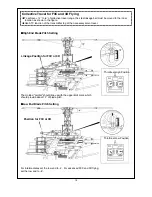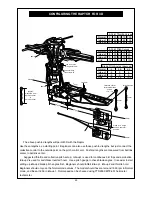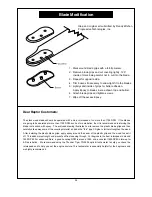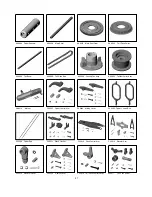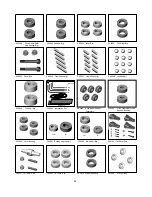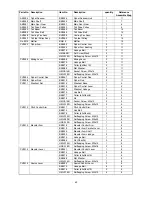
31
After Flight Checklist
(1) Check every screw and bolt to make sure none has loosened due to vibration.
(2)Check every rotating and movable part to ensure they still move smoothly and
normally.
(3) Clean off the exhaust residue from the muffler, engine, and helicopter.
(4) Check all movable parts, such as gears, ball links, belt, etc. for unusual wear.
Trouble Shooting
[1]The engine will not start.
* The engine starting shaft will not turn:
The engine may be flooded with too much fuel. Please remove the glow plug first, then turn the engine
with the electric starter until the excess fuel spits out of the glow plug hole.
* The engine turns when the electric starter is applied, but the engine will not start:
(1) Is the glow plug working? Remove the glow plug, does the platinum coil glow red when a 1.5 volt
battery is applied to the plug? If not, then the glow plug battery may be weak and old.
(2) Is the carburetor needle properly set? Please refer to the engine instruction manual for proper
needle setting.
(3) Does the throttle control arm move properly and in the correct direction according to your transmitter
command?
* Engine will start, but quits immediately.
(1) Use the transmitter to increase the carburetor opening slightly. The throttle stick should never
exceed the 1/3 position when starting the engine.
(2) Try a new or different type of glow plug. There are different types of glow plugs on the market for
different types of fuel and operating conditions. Seek the advice of experienced fliers and also
experiment with different types of glow plugs until you find one that suits your operating condition
best.
* Engine runs, but the helicopter will not lift off.
(1) Check the main rotor blade pitch angle, it should be set at 5.5 to 6 degrees when the transmitter
throttle/collective stick is at the center position.
(2) Does the engine throttle arm move properly? The carburetor opening should be fully open when the
transmitter throttle/collective stick is moved up. The carburetor opening should be completely closed
when the transmitter throttle/collective stick is moved down and the throttle trim is also moved down.
(3) The carburetor needle is not set properly. Close the needle (turn it clockwise) all the way, then open
the needle (turn it counter clockwise) 1 and 1/2 turns and try again. If the model still will not lift, then
the engine may be running too rich. If the symptom is the engine exhaust has a lot of smoke and the
engine coughs and wants to quit when the transmitter throttle/collective stick is moved up, then
close the needle 1/8 turn at a time, until the model will lift off. Do not turn the needle too far inward,
that will make the engine run too lean and over-heat and damage the engine.
[2] Helicopter problems.
* The helicopter shakes.
(1) Is the blade spindle bent?
(2) Is the flybar bent?
(3) Is the main rotor shaft bent?
(4) Are the two control paddles mounted at the same distance from the rotor shaft, are the paddles
parallel to each other, and in the proper direction?
(5) Is the tail rotor shaft bent? The tail rotor blades mounted properly or damaged?
(6) Are the main rotor blades damaged or mounted in the proper orientation? The blades may require
additional balancing. The blade balance can be checked by removing both blades and then use one of
the 4 mm blade bolt and nut to hold the two blades together like a teeter totter. Then, hold the blade
bolt with your thumb and index finger. The two blades should teeter and remain in a level position. If
not, then add some tape to the lighter blade near the blade tip until the two blades teeter in a level
position. Hobby shops also sell blade balancers that are designed solely for balancing model
helicopter blades.
Summary of Contents for RAPTOR 30
Page 1: ......
Page 24: ...22 FLIGHT TRAINING SECTION...
Page 32: ...30 MAINTENANCE SECTION...
Page 38: ...36 PARTS LIST SECTION...



